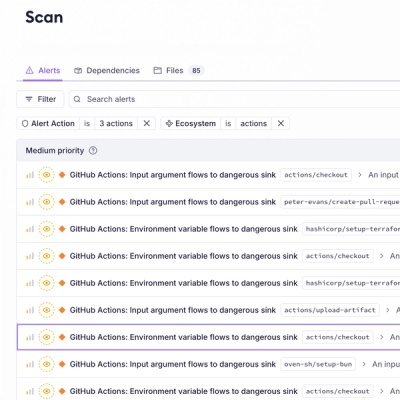
Product
Introducing Socket Firewall Enterprise: Flexible, Configurable Protection for Modern Package Ecosystems
Socket Firewall Enterprise is now available with flexible deployment, configurable policies, and expanded language support.
@justeat/core-analytics
Advanced tools
Core Analytics - A utility that encapsulates the sending of Analytics via Snowplow & GTM (Google Analytics) functionality

Encapsulates Snowplow & GTM (Google Analytics) functionality
This component abstracts away the gathering of the various data values needed for Google Analytics (GA) and the setting up of Google Tag Manager (GTM).
Once registered and the site is running it will prepare each page with the required GTM head tag for pushing analytics to GA.
You can see the GTM tag and any GA data by inspecting the head tag of the page and the dataLayer from the browser console in developer tools. If you exercise all the current functionality you will be able to see the following models {platformData: {…}}, {userData: {…}}, {pageData: {…}} & {event: ...} in the dataLayer.
platformData, userData and pageData.options) if the need arises.Install the module using npm or Yarn
yarn add @justeat/core-analytics
npm install @justeat/core-analytics
Import & Register
core-analytics exposes a simple class that performs various steps in the 'constructor' during initialisation to prepare the service for use. When instantiating the service it allows you to pass in 'options' (see the Options section) that allow you to configure some of the static values that may need to change in your environment
In the example below it demonstrates how to declare and instantiate the core-analytics service and how you can create the options to pass into the service;
import AnalyticService from '@justeat/core-analytics';
const req = this.req; // Get a handle to the current request
const options = {
featureName: 'checkout-web',
locale: 'en-GB',
id: 'GTM-ABC123X'
};
const service = new AnalyticService(req, options);
Methods
pushPlatformData()Evaluates and gather data for the platformData GA model and pushes it to the dataLayer
this.
$gtm.pushPlatformData({ featureName:custom-web, locale:en-AU, customFields: { custom1: 'one', branding: 'new20' } });
(object) {
- (string)
featureName(optional) (default is whatever was set at the point of registration or whatever was reset using thesetOptions()method. You may want to change this if working in on a SPA site and you want to change the feature name everytime the active page changed. Note that this will not persist the value unlike the actions ofsetOptions()method)- (string)
locale(optional) (default is whatever was set at the point of registration and if not set at that point then the Options default. Note that this will not persist the value unlike the actions ofsetOptions()method)- (object)
customFields(optional) (You may want to overwrite/add fields and this parameter allows you to indicate an object of fields/values that if already present will overwrite and if not then will be append to the model)
}
(object)
platformDatamodel
This will be the model constructed and pushed to the datalayer (handy for testing and debugging)
This is ideally only called once per page so it is best suited in the parent page component.
./pages/checkout/index.vue
<script>
...
window.onload = function() {
this.service.pushPlatformData();
};
...
</script>
pushUserData()Evaluates and gather data for the userData GA model and pushes it to the dataLayer
this.
$gtm.pushUserData({ authtoken:eyJhbGciOiJIUzI1NiIsInR5cCI6IkpXVCJ9..., customFields: { custom1: 'one', role: 'admin' } });
(object) {
- (string)
authToken(optional)- (object)
customFields(optional) (You may want to overwrite/add fields and this parameter allows you to indicate an object of fields/values that if already present will overwrite and if not then will be append to the model)
}
(object)
userDatamodel
This will be the model constructed and pushed to the datalayer (handy for testing and debugging)
This is ideally only called everytime the User status changes so it might best suited in a login method.
The method is very dependant on the authToken parameter and without it the userData model will only contain the anonymous user id.
<script>
...
loggedIn (success) {
if (success === true) {
this.service.pushUserData({ authToken: this.authToken });
}
}
...
</script>
pushPageData()Evaluates and gather data for the pageData GA model and pushes it to the dataLayer
this.
$gtm.pushPageData({ pageName:accounts sign-up, customFields: { custom1: 'one' } });
(object) {
- (string)
pageName- (number)
httpStatusCode(optional)(only override this if you wish to change the default 200, i.e you may be displaying a custom static 404 page and want to record the value 404 instead of 200 or you may be displaying a successful account creation page and want to record the value 201 rather than 200)- (object)
customFields(optional) (You may want to overwrite/add fields and this parameter allows you to indicate an object of fields/values that if already present will overwrite and if not then will be append to the model)
}
(object)
pageDatamodel
This will be the model constructed and pushed to the datalayer (handy for testing and debugging)
This is ideally called everytime the Page status changes, i.e. new page displayed, orientation changed, etc..
setOptions()Overrides the current Option values
this.
$gtm.setOptions({ featureName:checkout-web, locale:en-IE});
(object) {
- (string)
featureName(optional)- (string)
locale(optional) (default is whatever was set at the point of registration and if not set at that point then the Options default. Note that this method will persist the value)
}
(object)
optionsmodel
This will be the current Options model (handy for testing and debugging)
If working in on a SPA site and you want to change the feature name everytime the active page changes then use this method to override the featureName at the same time so all subsequent analytics contain the correct featureName. You may also need to change the current active locale and as such you will need to use this method to reset the locale at the same time so all subsequent analytics contain the correct data.
Note that this method will persist the value/s until this method is called again or the plugin is re-registered.
getOptions()Gets the current Option values
this.
$gtm.getOptions();
(object)
optionsmodel
This will be the current Options model.
pushEvent()Pushes the given event object to the dataLayer
this.
$gtm.pushEvent({ event object ... });
(object)
event
(object)
eventmodel
This will be the model constructed and pushed to the datalayer (handy for testing and debugging)
This can be called at ad-hoc times to indicate an action, event or status as required by your Analytics team. The shape of the event object will be dictate by your Analylics team
If this method is executed serverside then although the event cannot be pushed to GA (because it needs a GTM prepare DOM) it will be store internally until the plugin has re-registered clientside then any stored events will be pushed to GA.
<script>
...
if (isLoggedIn(type)) {
const loggedInEvent = {
event: 'loggedIn-`${type}`',
experiment: {
id: 'EX-1234',
name: 'Some experiment',
platform: 'experiment_api',
variant: {
name: 'increase_a'
},
version: 1
}
};
this.service.pushEvent(loggedInEvent);
}
...
</script>
Note: although core-analytics gathers most of it's analytical data from within it does rely on some specific values to be supplied by your feature via an options object. See object spec. below:
| Prop Name | Example | Optional/Required | Default | Description |
|---|---|---|---|---|
| featureName | 'coreweb' | Required | This is used to identify analytics sent by your feature | |
| locale | 'en-GB' | Optional | en-GB | This is used to calcualate various platform data values |
| id | 'GTM-X1234Z' | This is used know what GA account to push analytics to | ||
| auth | 'authKey' | Optional | Please speak to your Analytics team for more information about this option | |
| preview | 'preview id' | Optional (required if auth supplied) | Please speak to your Analytics team for more information about this option | |
| cookiesWin | 'x-je-gtm_cookie' | Optional (required if auth supplied) | Please speak to your Analytics team for more information about this option |
* Note; you don't have to supply the 'options' object (i.e. if testing) but the component will only operate in a limited capacity without it.
Although this component can gather most data with only the options object it also needs some values that may only be available on the serverside. These can be passed in as 'custom' fields.
e.g.:
| Prop Name | Type | Example | Description |
|---|---|---|---|
environment | Server Environment Variable | staging | This will indicate the current environment |
version | Server Environment Variable | 1.12.345.0 | This will indicate the current version of the feature |
instancePosition | Server Environment Variable | 004 | This will indicate the current position of the AWD EC2 instance |
isPilot | Server Environment Variable | false | This will indicate whether the server is a pilot or not |
Start by cloning the repository and installing the required dependencies:
$ git clone git@github.com:justeat/fozzie-components.git
$ cd fozzie-components
$ yarn
$ yarn build
Change directory to the core-analytics package:
$ cd packages/services/core-analytics
To test all components, run from root directory.
To test only core-analytics, run from the ./fozzie-components/packages/services/core-analytics directory.
yarn test
FAQs
Core Analytics - A utility that encapsulates the sending of Analytics via Snowplow & GTM (Google Analytics) functionality
We found that @justeat/core-analytics demonstrated a not healthy version release cadence and project activity because the last version was released a year ago. It has 29 open source maintainers collaborating on the project.
Did you know?

Socket for GitHub automatically highlights issues in each pull request and monitors the health of all your open source dependencies. Discover the contents of your packages and block harmful activity before you install or update your dependencies.

Product
Socket Firewall Enterprise is now available with flexible deployment, configurable policies, and expanded language support.

Security News
Open source dashboard CNAPulse tracks CVE Numbering Authorities’ publishing activity, highlighting trends and transparency across the CVE ecosystem.

Product
Detect malware, unsafe data flows, and license issues in GitHub Actions with Socket’s new workflow scanning support.